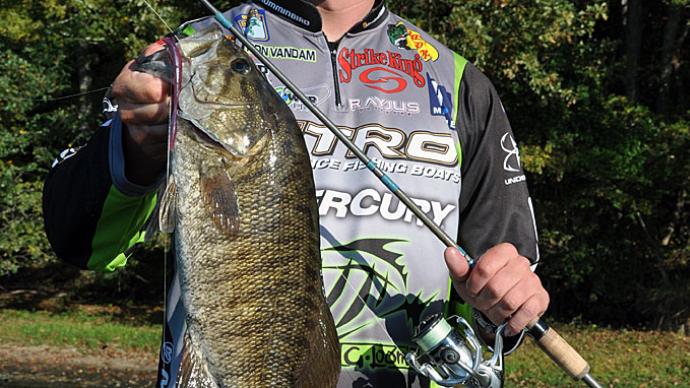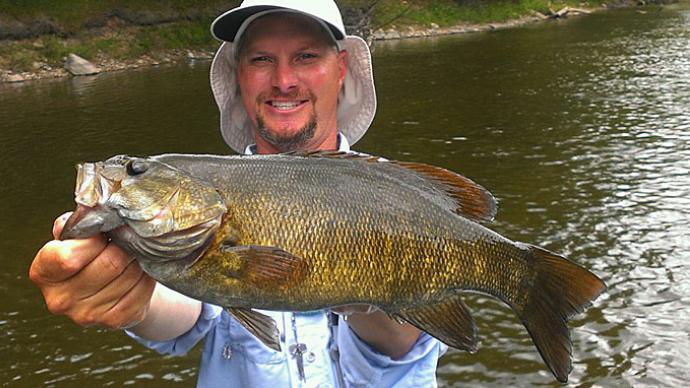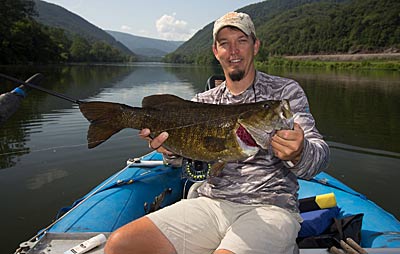
Fish a river often enough, and you’ll see it change: clear water turns muddy or slow current quickens. Some transformations are done in days, while others take much longer. It’s never the same for long.
Water levels, for example, can rise rapidly after a storm or warm spring weekend of snowmelt. But it also changes over the long term, dropping as rainfall becomes sporadic during late summer and fall. Britt Stoudenmire sees the latter almost every year, from August through October, on the New River, unless the remnants of a hurricane or two cross his corner of southwestern Virginia. “The river will get shallow that time of year,” he said.
Stoudenmire owns New River Outdoor Co., guiding anglers to muskies in winter and smallmouth the remainder of the year. It provides him the opportunity to see the river under a variety of conditions. Low and clear is one of his favorites, especially when he’s hunting the river’s biggest smallmouth, which easily pass 20 inches in length. “The lower the water, the more of the river you can fish,” he said. “A lot of times, high water pushes fish [into fewer places].”
The New — one of the world’s oldest rivers — resembles many rivers. It’s a mix of slow and moderate water filled with rock structure with wood and vegetation providing cover. It’s a handful of boat lengths wide, and the fishing tactics produced during low water here will work anywhere anglers chase hard-fighting river smallmouth.
Understand the environment
Low water in late summer and fall isn’t unique to rivers. Lakes and reservoirs typically dip to their lowest level during that time. While most years it’s due to a lack of precipitation, droughts will drop the water level, too, extending the low water season earlier into the summer and later into the fall. Stoudenmire said those years can offer the best low-water fishing, though droughts are more likely to reduce the amount of fishable water.
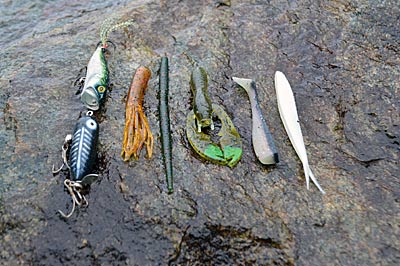
While the start of the low-water season is blurred because it’s a slow process, the end is usually more abrupt. Stoudenmire said the first big cold fronts to sweep through the region — usually in October — will push the smallmouth into deeper wintering spots, which lack significant current.
Low water is clear water because less runoff washes less sediment into the river. Stoudenmire said that allows smallmouth to see better, a favorable situation for these sight feeders. But it also means they are more aware of your presence. “They definitely can get an eye on you quicker,” he said. While that may spook them, he qualifies their reaction as more of heightened awareness. Seeing you may not push them from a spot, he said, but they will be more cautious about eating a lure.
Smallmouth see best when the sun is shining brightest. “I catch my biggest fish in low water between 10 a.m. and 2 p.m.,” Stoudenmire said. That timeframe is essential for one more reason.
Stoudenmire said rivers at a low water level have less dissolved oxygen than at a higher level. That’s because there isn’t enough water to tumble over rocks and gurgle through rifles, where most aeration occurs. Instead, he said oxygen is added to the water by aquatic vegetation, from microscopic size on up, as a byproduct of their photosynthesis. Most oxygen is produced during midday when the sun is brightest. Then, the system becomes charged with oxygen, which he feels makes bass more active.
Plan your attack
When faced with dropping or low water, most anglers are wired for the same conclusion: Find deeper water. And that makes sense. If a lake drops 12 inches, for example, bass have to leave places that were a foot or less deep. It’s a simple conclusion, but Stoudenmire said it’s the wrong one in smallmouth rivers. “People aren’t aware of how shallow big fish will go,” he said.
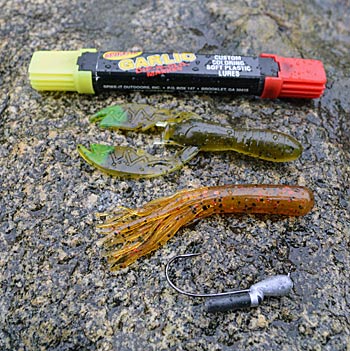
Stoudenmire routinely finds smallmouth as shallow as 8 inches of water during low-water periods. Most are tucked against the bank, though you can still catch some from midriver structure. Combine the shallow water with the ability to see better, and you have to perfect your approach if you want to catch them.
Keep the bass in front, not behind, of the boat as it drifts downstream or you as you walk the bank. That keeps the hyper-aware bass from seeing you, Stoudenmire said. “The worst thing you can do in low and clear water is thrown on top of them,” he said. Instead, cast downstream at a 45-degree angle, aiming for your lure to land 7 to 8 feet in front or behind them. The splash acts as an attractor, he said.
Making specific casts starts with knowing where low-water smallmouth hold. When you have that information, Stoudenmire said you can stay farther away and plan your casts, decreasing the chance you’ll tip them off to your presence. Low-water periods also are the perfect time to scout spots that might be productive when the water level rises.
Stoudenmire pays attention to other anglers on the river. The more pressure and activity, the tougher low-water smallmouth are to catch. He said even a kayaker, slowly and quietly paddling down a bank, can turn off the smallmouth in that stretch. He chooses his spots to avoid as much competing for traffic as possible.
But like all rules, Stoudenmire offers an exception to his. Smallmouth can’t see well when the water has some color. When he’s lucky enough to find that situation, he knows it will take more to disturb the bass, so he doesn’t hesitate to fish behind an angler or paddler.
Choose natural-looking lures
Most of the low-water smallmouth that Stoudenmire catches are tucked along the bank. It’s there that they find shelter and utilize ambush points among the overhanging trees and laydowns. He said they also find a major source of late summer food: cicadas.
These winged insects making the buzzing sound that most people associate with late-summer evenings. While some species spend as many as 17 years underground before hatching, others arrive annually. Stoudenmire said river smallmouth eat the latter ones as they fall into the water from riverside trees.
Stoudenmire targets bank-bound smallmouth bass with a fly rod, casting dry flies that imitate cicadas going for an unwanted swim. While these are irresistible to smallmouth, including some of the biggest he catches each year, they aren’t the only option. If you’re more comfortable swinging a spinning or casting rod, he said dead drifting a topwater, such as Rebel’s Pop-R, against the bank will produce smallmouth.
Low-water smallmouth will eat a host of lures, as long as they appear lifelike. They’ll readily attack soft-plastics lures — finesse worms, tubes, stick worms such as a Yamamoto Senko, craws and jerkbaits. In addition to being aggressive sight feeders, smallmouth, like their largemouth cousins, are curious. Add a rattle to a tube jig or touch of chartreuse dye to the tip of a soft-plastic worm or crawfish to draw their attention.
Stoudenmire said soft-plastic lures often work better for fishing mid-river structure, which can be as productive as the bank during low water, especially after the cicada hatch ends. He starts his mid-river search along the second drop off from the bank. These ledges provide a current break and enough shade to form an ambush point. He also fishes “push water,” the bulge upstream of an obstacle such as a log or boulder. Tucked in these tight spots, smallmouth have a clear shot at any prey that’s washed downstream.
With less water bringing snags and abrasive rocks closer to the action, choose slightly heavier gear to successfully land low-water smallmouth. Stick with spinning setups, but step up to a medium-heavy power rod, which will offer more control over a hooked fish. Load the reel with 15- to 30-pound test braided line, tying on a 2- to 3-foot leader of nearly invisible fluorocarbon — choose monofilament, which floats, unlike fluorocarbon, when fishing a topwater — to encourage sharp-eyed smallmouth to strike. Select as strong a pound test as you feel you can get away with under the conditions, lighter when its bright and heavier when it’s cloudy.



